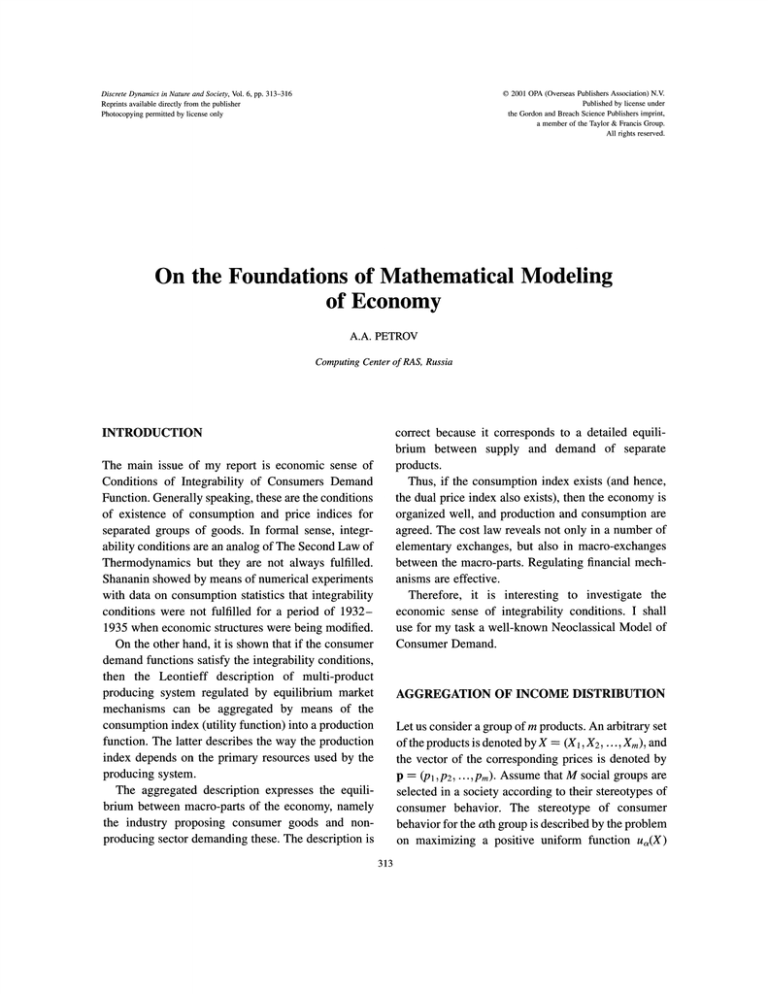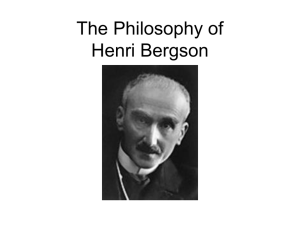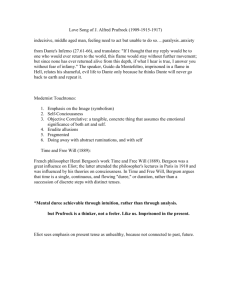
OPA (Overseas Publishers Association) N.V.
Published by license under
the Gordon and Breach Science Publishers imprint,
member of the Taylor & Francis Group.
All rights reserved.
Nature and Society, Vol. 6, pp. 313-316
Reprints available directly from the publisher
Photocopying permitted by license only
(C) 2001
Discrete Dynamics in
On the Foundations of Mathematical Modeling
of Economy
A.A. PETROV
Computing Center of RAS, Russia
INTRODUCTION
correct because it corresponds to a detailed equilibrium between supply and demand of separate
The main issue of my report is economic sense of
Conditions of Integrability of Consumers Demand
Function. Generally speaking, these are the conditions
of existence of consumption and price indices for
separated groups of goods. In formal sense, integrability conditions are an analog of The Second Law of
Thermodynamics but they are not always fulfilled.
Shananin showed by means of numerical experiments
with data on consumption statistics that integrability
conditions were not fulfilled for a period of 19321935 when economic structures were being modified.
On the other hand, it is shown that if the consumer
demand functions satisfy the integrability conditions,
then the Leontieff description of multi-product
producing system regulated by equilibrium market
mechanisms can be aggregated by means of the
consumption index (utility function) into a production
function. The latter describes the way the production
index depends on the primary resources used by the
products.
Thus, if the consumption index exists (and hence,
the dual price index also exists), then the economy is
organized well, and production and consumption are
agreed. The cost law reveals not only in a number of
elementary exchanges, but also in macro-exchanges
between the macro-parts. Regulating financial mechanisms are effective.
Therefore, it is interesting to investigate the
economic sense of integrability conditions. I shall
use for my task a well-known Neoclassical Model of
Consumer Demand.
AGGREGATION OF INCOME DISTRIBUTION
Let us consider a group of rn products. An arbitrary set
of the products is denoted by X (X, X2,
Xm), and
the vector of the corresponding prices is denoted by
p (/91,P2,...,pm). Assume that M social groups are
selected in a society according to their stereotypes of
consumer behavior. The stereotype of consumer
behavior for the ath group is described by the problem
on maximizing a positive uniform function u(X)
producing system.
The aggregated description expresses the equilibrium between macro-parts of the economy, namely
the industry proposing consumer goods and nonproducing sector demanding these. The description is
313
A.A. PETROV
314
subject to the budget constraint (p,X) <- I, X >- 0,
where I,, is the income of the ath group used for
consumption. We assume that the utility function
u,(X) belongs to the class Am and u(X) 0 for X
0R .
If the normalized demand functions of the ath
group is denoted by y(p) then its demand is given
as Io(P). Thus, the price index from the point of
view of the ath group is determined using the
formula
q (p)
inf
u (X)
X >- O, u(X) > 0
and the total consumption fund of the society is
M
given by I
I.
According to the neoclassical theory, we assume
that the way the income is distributed among the
social groups depends on the prices p. Indeed,
changes in price structure cause changes in social
behavior of population. Real income, in particular,
changes, and this results in migration from one social
group to another. The distribution of income among
the groups also changes.
The part of income of the ath social group [qg(p)]
in the total consumption fund I is given by p(p)
I,/I, assuming that p,(p) are positively uniform
functions.
Let us calculate the total consumer demand of the
society Iy(p) which unites the demands of social
groups. It is clear that y(p) satisfies the separability
conditions.
Y=I
Proposition 1. The differential form
can be represented as
of the demand
M
y(p)dp
qg(p)
dq(p)
Z
q(P)
:
(1)
The vector ofprice indices calculated from the points
of view of various groups is denoted by q(p)=
(ql(P), q2(P), qM(P)), assuming that the system of
functions q(p) is functionally independent.
Proposition 2. Assume that there exists a consumption index F(X and price index Q(p) belonging to the
class Am and corresponding to the demand functions
y(p). Then there exists a function @(q) such that
Q(p)-- cI)(q(p)) and
,(p)
ce
(q(p)
qf---))(Oq)
(q(P))’
(2)
1, ...,M.
The interpretation of Proposition 1 complements
that of equilibrium theory of aggregation. Now we
have proved that for the integrability conditions to
be satisfied for the demand functions y(p), it is
necessary that the distribution {q(p)} of income
among social groups depend implicitly on the
prices, i.e. depend on the price indices q(p) by
which various social groups estimate the level of
consumer prices. This implies that the distribution
of income in the society should agree with the
estimates of price level existing in the society. This
can be interpreted in a logical manner. Selfregulating mechanisms for distributing income
should work in the society. Thus, we see that
mechanisms should exist for self-regulating economical processes and relations between economic
agents. Economists associate them with market
mechanisms. This, in particular, concerns Proposition 1. It is asserted that good markets cannot
work in a normal way if labor market does not
exist.
Thus assume that the distribution of income
depends on the prices in terms of the indices q(p),
6(q(p)), a 1,..., M.
If the distribution of income can be represented
like in Eq. (2) at some function qr(q), then the
differential form of demand (y(p), dp) satisfies,
clearly, the integrability conditions. In order for the
price index Q(p)--q(q(p))q(p)= qb(q(p)) to be
continuous, convex and monotonously nondecreasing on R + for any q(p) satisfying the same
conditions, it is necessary and sufficient that the
function qb(q) also satisfies the same conditions for
the economic indices.
namely q(p)
MATHEMATICAL MODELING OF ECONOMY
The function Oh(q) turns out to be connected with
Bergsonian Function of Welfare. Let us consider the
function dual to Oh(q), namely
W(u)
inf
(q’ u)
q -> O,
I, q/)(q)
@(q) > 0}
(3)
where u= (ul,u2,...,ut) is the vector of utility
functions of various social groups.
Proposition 3. Let @(q)
CAm. Put fi(q)=
(1/@(q))(b@(q)/Oq), ce= 1,...,M. Then fi(q)=
(fil(q),fi2(q),
M(q)(q)) is a solution to the optimization problem
W(u)max subject to (q,u)-< 1,
u->0.
In economical theory, the function W(u is referred to
as the Bergsonian welfare function. Let us consider
how it is related to the consumption index F(X ).
Proposition 4. Let cI)(q) Am, and let {q(p)} be
defined by the formula Eq. (2). Then the consumption
index F(X) is not less than the optimal value of the
functional in the equation
W(ul(X1), Ul(X2),
UM(XM)) :=# max
M
subject to
E X =X’
X -> 0,
(4)
c--1
a
1,...,M.
If X I.y(p) for some p>0, then F(X) is equal to
the optimal value of the functional in Eq. (4).
Usually, political economy studies the problem on
fair distribution of income in the society. Generally, a
concept of fairness is proposed to which the
distribution of income should correspond. The
concept is expressed formally by the Bergson
function. This is a specially constructed function
whose maximum is attained just at the distribution of
income corresponding the concept.
315
The Bergson function expresses a compromise
between economical interests of social groups, and
can be treated as a political "party program". It seems
that the program can be prescribed directly by the
functions 6(q(p)), a 1, ...,M, of income distribution. But the demand functions that satisfy the
integrability conditions corresponding to the functions
of income distribution are generated by some Bergson
function. A "party program" which does not satisfy
the integrability conditions disorganizes the economical system, and cannot be considered as constructive.
Economical agents with rational behavior would not
support such a program.
If all the social groups agree with a program, then
Eq. (2) generates the distribution of income, which
ensures that the integrability conditions are satisfied
for ultimate demand functions.
Finally, a social agreement generates economic
structures which ensures self-organization of the
economic agents, allows the cost law to hold, and
makes financial regulating mechanisms maximally
effective.
NONPARAMETRIC METHOD FOR
ANALYZING BUDGET STATISTICS
To construct numerically the Bergson function, we
need initial information. Usually, this is the budget
T; a 1
statistics {X t, ptlt- 1
M}, where
p are prices at the time period t, and X t’ is the
consumption vector of the cth social group at the time
period t. Applying the nonparametric method for
constructing economical indices (represented in the
report by the "trade statistics" {X t,,ptlt-1, ...,T; ce-- 1, ...,M} of the ceth social group, we
can construct the price index q(p) from the point of
view of the ath social group. Putting u at (pt’xt’)
q(p)
and applying the nonparametric method,
{q(pt),utlt 1, T; u (u] U2," UtMt)} considered as trade statistics, we obtain the consumption
index which is just the Bergson function generating
the observed distribution of income. Thus the
developed methods can be applied for analyzing
budget statistics.
316
A.A. PETROV
The obtained results explain the Bergson function
in a new way. Now it not only formalizes a
normative concept of fair income distribution, but
also characterizes the real distribution of income
existing in the society. If real distribution of income
between social groups can be described by means of
a Bergson function, then the consumption of the
society as a whole can be characterized by one
index, and the price level can be characterized by
the price index. In this case economy is organized
well, and financial mechanisms regulate effectively
the distribution of resources. On the other hand, this
implies that social groups achieved a compromise in
distributing income.
We can also try to find a subset of social groups
whose distribution of income can be described by its
own Bergson function. If so, a compromise is achieved
between social groups of this subset. Then the latter can
be considered as a single group and characterized by
one consumption index and the corresponding price
index. Thus we can construct trees of social groups
which characterize correctly the social structure of the
society. Studying such social structures is of separate
interest in making social and political decisions.




